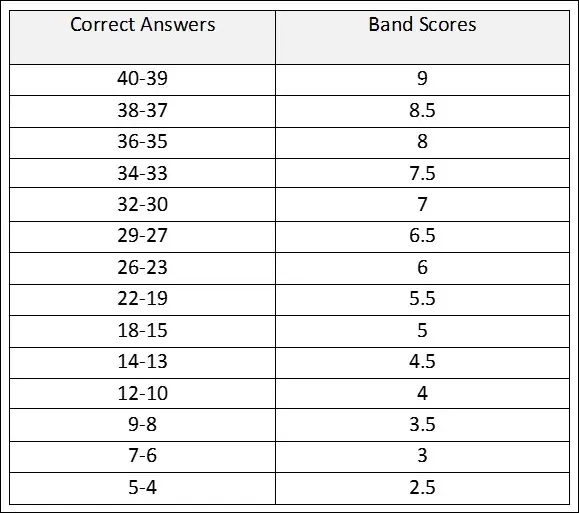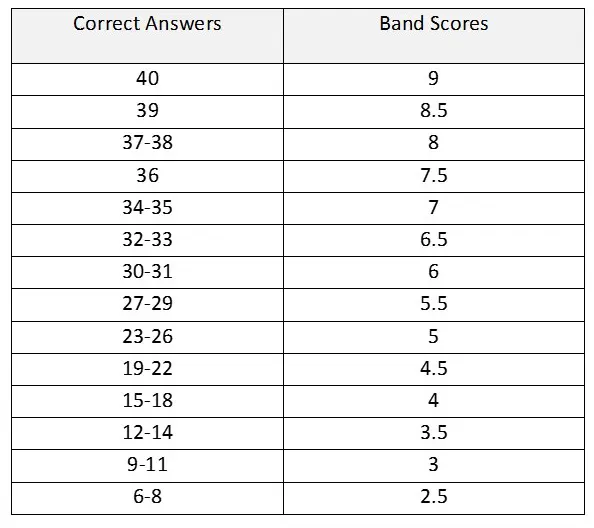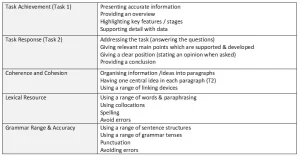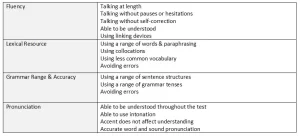If you’re preparing to take the IELTS exam, you’ve probably heard of band scores. However, many test-takers are uncertain about how these scores are calculated. It can be frustrating to study hard and still receive lower scores than expected.
In this blog post, we will explore the intricacies of the IELTS scoring system and shed light on why scores may vary from one sitting to another. Understanding the scoring system will help you prepare effectively and increase your chances of achieving your desired band score.
How the IELTS Band Scores are Calculated?
The IELTS score is a measure of your English ability, and it’s calculated in three different ways. You’ll get an overall band score for each skill (listening, reading, writing) as well as an overview band which averages all the skills together. The scoring system ranges from 0 to 9 – with .5 scores available too!
How can I Calculate my IELTS Band Scores?
A general description of the competency level for each of the nine bands is reprinted from the IELTS website with permission.
IELTS Band Scores are reported in whole or half bands. The overall band requirement for each institution or government body may be different. A band of 6.5 or 7 is a common requirement for university admission.
- If your overall score is an average of 6.25, your score will be increased to 6.5.
- If your overall score is an average of 6.75, your score will be increased to 7.
- If your overall score is 6.1, your score will go down to 6.
- Your score is rounded up or down to the nearest 0.5 or whole score as shown above.
You can Calculate this information on the official British Council IELTS Website: Visit The Website
Band Score Descriptions
The table below gives a description of each band score with information about the level of English required for band scores 0 to 9.
| 9 | Expert User | Has fully operational command of the language: appropriate, accurate, and fluent with complete understanding. |
| 8 | Very Good User | Has fully operational command of the language with only occasional unsystematic inaccuracies and inappropriacies. Misunderstandings may occur in unfamiliar situations. Handles complex detailed argumentation well. |
| 7 | Good User | Has operational command of the language, though with occasional inaccuracies, inappropriacies, and misunderstandings in some situations. Generally handles complex language well and understands desired reasoning. |
| 6 | Competent | Has generally effective command of the language despite some inaccuracies, inappropriacies, and misunderstandings. Can use and understand fairly complex language, particularly in familiar situations. |
| 5 | Modest User | Has partial command of the language, coping with overall meaning in most situations, though likely to make many mistakes. Should be able to handle basic communication in their own field. |
| 4 | Limited User | Basic competence is limited to familiar situations. Has frequent problems in understanding and expression. Is not able to use complex language. |
| 3 | Extremely Limited User | Conveys and understands only general meaning in very familiar situations. Frequent breakdowns in communication occur. |
| 2 | Intermittent User | No real communication is possible· except for the most basic information using isolated words or short formulae in familiar situations and to meet immediate needs. Has great difficulty understanding spoken and written English. |
| 1 | Nonuser | Essentially has no ability to use the language beyond possibly a few isolated words. |
| 0 | Did not attempt the test | No assessable information provided. |
IELTS Listening Scores
The number of right answers you have out of the 40 questions in the test determines your listening scores. Incorrect responses do not result in a loss of points.
IELTS Reading Score
Your reading scores are calculated by the number of correct answers you have out of the 40 questions in the test. You do not lose points for incorrect answers.
IELTS Reading Score Academic
The IELTS Reading score for the Academic module is also reported on a scale of 0-9, in half-point increments. Like the General Training Reading test, the Academic Reading test consists of 40 questions, and the raw score is calculated based on the number of correct answers.
The Academic Reading test is designed to assess a range of skills, including reading for gist, identifying the main ideas and supporting details, understanding the writer’s purpose and attitude, understanding the organization of a text, and recognizing relationships between ideas.
The score requirements for different purposes may vary, but typically a score of at least 6.5 is required for entry to undergraduate or postgraduate programs, while a score of 7 or above may be required for higher-level academic programs, professional registration, or research positions. However, the score requirements can vary depending on the institution or organization you are applying to, so it’s always important to check their specific requirements.

IELTS Reading Score General Training
The IELTS Reading score for the General Training module is reported on a scale of 0-9, in half-point increments. The Reading test consists of 40 questions, and the raw score is calculated based on the number of correct answers. The raw score is then converted to the IELTS 9-band scale, which is used to report the overall score.
The Reading test assesses a range of skills, including reading for gist, reading for main ideas, understanding explicit and implicit information, identifying opinions, attitudes and purpose of a text, and understanding the writer’s tone, attitude and purpose.
The score requirements for different purposes vary, but typically a score of at least 6 is required for entry to academic programs and for immigration purposes, while a score of 7 or above is often required for professional registration and for higher-level academic programs. However, it’s always best to check the specific score requirements of the organization or institution you are applying to.

IELTS Writing Assessment Criteria
IELTS (International English Language Testing System) Writing assessment criteria evaluate a candidate’s writing skills based on the following four areas:
- Task Response: The candidate’s ability to address the prompt, present relevant and well-developed ideas, and maintain a clear and coherent overall message.
- Coherence and Cohesion: The candidate’s ability to organize ideas logically, use appropriate linking words and phrases, and create a clear and cohesive text.
- Lexical Resource: The candidate’s ability to use a wide range of vocabulary accurately, appropriately, and flexibly, with few errors.
- Grammatical Range and Accuracy: The candidate’s ability to use a variety of sentence structures accurately, with appropriate use of verb tenses, subject-verb agreement, articles, and pronouns.
Each of these four areas is scored on a scale of 0 to 9, and the scores are then averaged to give an overall band score. For example, if a candidate receives a score of 7 for Task Response, 8 for Coherence and Cohesion, 6 for Lexical Resource, and 7 for Grammatical Range and Accuracy, their overall band score would be 7.0.
Both writing task 1 and task 2 are graded on the basis of four criteria. For more information on each criterion, see the table below.
To see the full version of the table, click on it.
IELTS Speaking Assessment Criteria
The IELTS Speaking Assessment Criteria are divided into four categories: Fluency and Coherence, Lexical Resource, Grammatical Range and Accuracy, and Pronunciation.
- Fluency and Coherence: This category assesses the speaker’s ability to speak with fluency and coherence. Fluency means the ability to speak smoothly without unnatural pauses or hesitations. Coherence refers to the ability to organize ideas logically and to connect them to each other. The speaker should be able to express themselves clearly and coherently.
- Lexical Resource: This category assesses the speaker’s ability to use a wide range of vocabulary appropriately. The speaker should be able to use a variety of words and expressions to express their ideas. They should also be able to use idiomatic expressions and collocations correctly.
- Grammatical Range and Accuracy: This category assesses the speaker’s ability to use a range of grammatical structures accurately. The speaker should be able to use a variety of sentence structures and tenses appropriately. They should also be able to use correct grammar and avoid errors.
- Pronunciation: This category assesses the speaker’s ability to produce clear and comprehensible speech. The speaker should be able to pronounce words correctly and use stress and intonation appropriately. They should also be able to use a natural rhythm of speech.
The IELTS Speaking test is marked on a band scale of 0-9, with half band scores available. Each of the four categories is given a band score, and the four band scores are then averaged to give an overall speaking band score.
The following are the IELTS speaking grading standards. To see the full version of the table, click on it.
Conclusion
In conclusion, understanding how IELTS band scores are calculated is crucial for anyone preparing to take the test. The assessment criteria focus on four key areas: Task Response, Coherence and Cohesion, Lexical Resource, and Grammatical Range and Accuracy.
By paying attention to each of these areas and practicing to improve your skills in each one, you can increase your chances of achieving the band score you need for your academic or professional goals.
Remember, preparation and consistent effort are key to success on the IELTS exam. Keep practicing and honing your skills, and you will be well on your way to achieving your desired band score.



